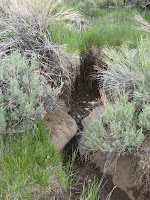 I've spent my share of time climbing over barbed wire fences while doing wildlife surveys, but now I'm responsible for some of them ! Our barbed wire fences are used to keep grazing livestock where they're supposed to be, whether it's within a certain area or outside of an area we want to protect, such as a meadow, riparian corridor, or aspen grove. Here, my coworker Casey shows me how we repair breaks in the fence. Don't tell him though, he hates having his picture taken. ;) The fences can break under pressure from the snow that covers the Bodie Hills in winter. One solution is the installation of "let-down" fences that can be put up or taken down with relative ease. We also use let-down fences in areas near sage-grouse leks, since the birds flying in to strut their stuff aren't always paying attention to where they're flying...
I've spent my share of time climbing over barbed wire fences while doing wildlife surveys, but now I'm responsible for some of them ! Our barbed wire fences are used to keep grazing livestock where they're supposed to be, whether it's within a certain area or outside of an area we want to protect, such as a meadow, riparian corridor, or aspen grove. Here, my coworker Casey shows me how we repair breaks in the fence. Don't tell him though, he hates having his picture taken. ;) The fences can break under pressure from the snow that covers the Bodie Hills in winter. One solution is the installation of "let-down" fences that can be put up or taken down with relative ease. We also use let-down fences in areas near sage-grouse leks, since the birds flying in to strut their stuff aren't always paying attention to where they're flying...Cool birds of the day: sage thrasher and green-tailed towhee.
And some semi-random bonus pictures:

Calochortus leichtlinii

each sheep flock has its own burro









































